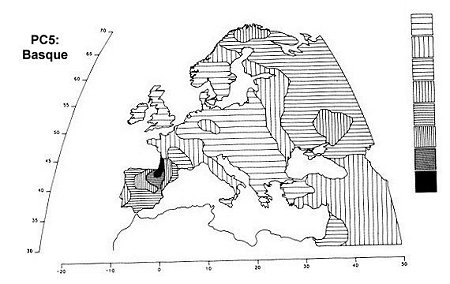EUROPEAN GENETIC VARIATION
Geneticist L. L. Cavalli-Sforza has used autosomal DNA to determine and map the five principal components that account for genetic variation in Europe. As it turns out, African ancestry is not one of them, meaning that it's as negligible in the South as it is in the North. Asian (Uralic) ancestry, however, is one of them, and it follows a clear Northeast to Southwest gradient, with its highest levels existing in Northern Scandinavia.
Hidden patterns in the geography of Europe shown by the first five principal components, explaining respectively 28%, 22%, 11%, 7%, and 5% of the total genetic variation for 95 classical polymorphisms:

|
THE FIRST component is almost superimposable to the
archaeological dates of the spread of farming from the Middle East
between 10,000 and 6,000 years ago. |

|
THE SECOND principal component parallels a probable spread
of Uralic people and/or languages to the northeast of Europe
[c. 4,000 years ago]. |

|
THE THIRD is very similar to the spread of pastoral nomads
(and their successors) who domesticated the horse in the steppe
towards the end of the farming expansion, and are believed by some
archaeologists and linguists to have spread most Indo-European languages
to Europe. |

|
THE FOURTH is strongly reminiscent of Greek colonization in
the first millennium B.C. |

|
THE FIFTH corresponds to the progressive retreat of the boundary of the Basque language. Basques have retained, in addition to their language, believed to be descended from an original language spoken in Europe, some of their original genetic characteristics. |
Neolithic Farmers: More information on the migrants associated with PC1.
Tat-C: This Y-chromosome lineage comprises much of PC2.
Indo-Europeans: More information on the migrants thought to be associated with PC3.
